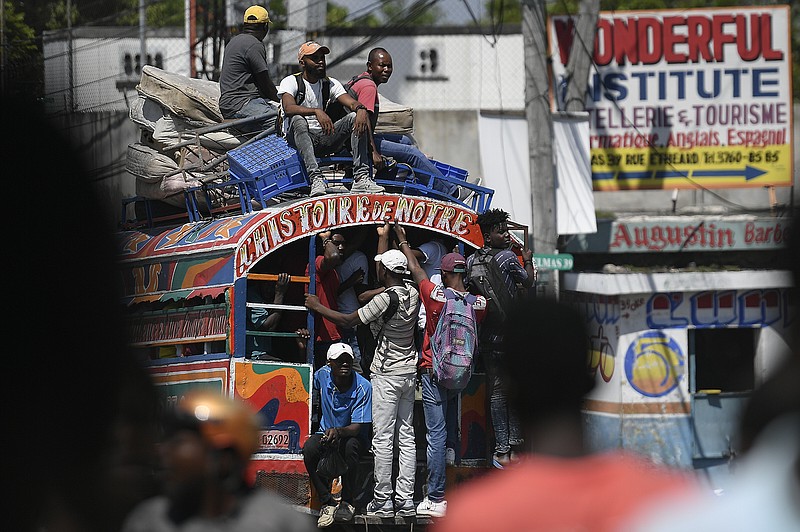PORT-AU-PRINCE, Haiti (AP) — The video shows more than 30 men lined up in front of a crumbling structure in silence. Their heads are bowed as a man walks between them and swigs from a small bottle. Someone exclaims, “There will be trouble in Port- au-Prince!”
Nearby, assault weapons are lined up against a wall, and two dozen handguns are scattered on the ground. Two large buckets are filled with bullets.
The men appear to be fresh recruits for one of Haiti’s most notorious street gangs, and the footage records their induction into the criminal underworld that increasingly rules the poorest nation in the Western Hemisphere. The video is emblazoned with the name “400 Mawozo” and “400 good for nothings,” both references to the gang police said is responsible for multiple killings and kidnappings, including the recent abduction of 17 people from a U.S.-based religious group.
The footage posted earlier this year is a gritty online brag that demonstrates the startling power of Haitian gangs as they seize control of more land and commit more crimes than ever before — all without a care. Their tightening grip on society threatens the country’s social fabric and its fragile, anemic economy.
“The situation is out of control,” said James Boyard, professor of political science at Haiti State University, who, like other experts, accused some politicians and business owners of funding gangs. “They made them too powerful. Now they are terrorized. They didn’t know things would go out of control the way they did.”
Gangs control up to 40 percent of Port-au-Prince, a city of more than 2.8 million people where gangs fight over territory daily. The street that belonged to one group yesterday may belong to a rival group the next day. Two leaders who previously shot at each other may form a brief alliance against a third before becoming enemies again.
There are dozens of gang names — Krache Difé, Torcel, Baz Pilot and 5 Secondes among them — but experts said only about 30 gangs are firmly established in the capital and surrounding areas. The largest and most powerful is thought to be “G9 Family and Allies” federation of nine gangs, which is run Jimmy Cherizier, a former police officer.
Gang violence waxes and wanes depending on the state of Haiti’s economy, its political situation and, at one point, the presence of United Nations peacekeepers. Currently, the country is still spinning from the July 7 killing of President Jovenel Moïse and a 7.2 magnitude earthquake that killed more than 2,200 people in August.
Those two events temporarily halted some gang activity, but kidnappings have surged in recent weeks. At least 328 kidnappings were reported to Haiti’s National Police in the first eight months of 2021, compared with a total of 234 for all of 2020, according to a report issued last month by the U.N. Integrated Office in Haiti.
The gangs’ growing power is most visible in the community of Martissant, which connects Port-au- Prince with the southern part of the country and is ground zero for at least three warring groups. The violence there has reached such extreme levels that many Haitians take hourlong detours to avoid the area, according to the local Le Nouvelliste newspaper.
Martissant’s abandoned police station is pockmarked with bullet holes, and bare- chested men with covered faces keep watch behind torched cars to ensure no one approaches.
In July, a gang opened fire on an ambulance and killed a nurse. The following month, gang violence forced Doctors Without Borders to close its Martissant clinic. On a recent Saturday, a group of armored police vehicles tried to cross the area and were shot at. The body of a dead civilian lay on the ground for the rest of the day.
Until recent years, turf wars were usually between gangs, with civilians sometimes caught in the crossfire. Then in November 2018, more than 70 people were killed in La Saline, a seaside slum in Port-au-Prince currently controlled by the G9 federation, whose leader was implicated in the massacre.
“Retaliation started escalating … so they started going after civilians,” said a top international official who was not authorized to speak to the media. “Now gang confrontations make no distinction between gangs and civilians.”
The same applies to kidnappings, which have targeted a hotdog vendor, priests, schoolchildren and wealthy business owners for ransom.
Experts believe much of this activity is driven by extreme poverty in a country where 60 percent of the population makes less than $2 a day and millions of people go hungry.
“Gangs are a way out, maybe the only way out of that situation,” Boyard said.
The country’s GDP dropped to -3.3 percent last year, the biggest decrease since the -5.7 drop that followed a devastating 2010 earthquake. In addition, the Haitian gourde depreciated more than 50 percent in the past year, and inflation remains above 10 percent, which has reduced purchasing power, said Haitian economist Enomy Germain.
This situation is comparable to the period that followed the 1991 coup that toppled former President Jean-Bertrand Aristide, Germain said.
Experts blame Aristide for creating the current gang phenomena. After returning to power in 1994, they say, he disbanded the army and began arming people in slums, many of whom he had influenced during his time as a Catholic priest.
Some gang recruits start as young as 6 or 7 and by their late teens occupy high-ranking positions. Few survive to 30. Members often refer to themselves as “soldiers.” An armed man who identified himself only as James said he is a mechanic and joined the Baz Pilat gang “to protect the ghetto from rivals that enter to steal, kill and rape.”

